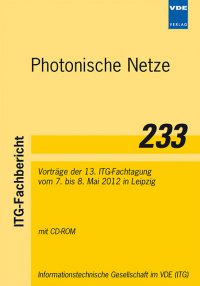Analysis of Ultra-High Bitrate Wireless Links as a Bridge for Optical Networks
Conference: Photonische Netze - 13. ITG-Fachtagung
05/07/2012 - 05/08/2012 at Leipzig, Germany
Proceedings: Photonische Netze
Pages: 4Language: englishTyp: PDF
Personal VDE Members are entitled to a 10% discount on this title
Authors:
Schneider, T.; Wiatrek, A.; Preussler, S. (Institut für Hochfrequenztechnik, Hochschule für Telekommunikation Leipzig, Gustav-Freytag Str. 43-45, 04277 Leipzig, Germany)
Braun, R.-P. (Deutsche Telekom AG, Telekom Innovation Laboratories, Winterfeldtstraße 21-27, 10781 Berlin, Germany)
Grigat, M. (Deutsche Telekom AG, Telekom Innovation Laboratories, Deutsche-Telekom-Allee 7, 64295 Darmstadt, Germany)
Abstract:
In photonic networks optical waveguides are used for the transmission of high data rates. Especially in impenetrable regions like mountains, rivers, bogs and suchlike wireless links could be a fast, simple and cost efficient way to build an extension to photonic networks. Only carrier waves in the Millimeter or Terahertz region of the electromagnetic spectrum offer sufficient bandwidths to support data rates required for transmission of optical waveguide channels. Especially the frequency range between 100 and 1000 GHz is very promising for such applications since first electronic circuits will be available for this frequency range on the market soon. In this paper we will discuss the capacity of wireless Millimeter- and Terahertz links for the bridging of distances of up to 1 kilometer. As we will show, five windows with bandwidths from 58 up to 94 GHz are available in the Terahertz-spectrum from 300 to 1000 GHz. Particularly in the upper Millimeter wave range (250 GHz) and in the first THz-window – with a center frequency of 338 GHz – it is, at least theoretically, possible to transmit data rates of more than 1.5 Tbps and 1 Tbps, respectively, with just one source and a transmitter power of only 10 dBm. On the other hand, this requires highly directive antennas with a very high gain of up to 70 dBi and an adaptive control of mechanical fluctuations of transmitting and receiving antenna.


